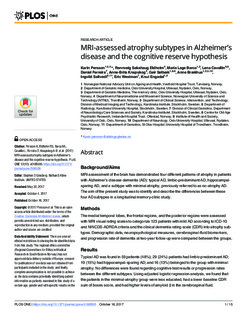| dc.contributor.author | Persson, Karin | |
| dc.contributor.author | Eldholm, Rannveig Sakshaug | |
| dc.contributor.author | Barca, Maria Lage | |
| dc.contributor.author | Cavallin, Lena | |
| dc.contributor.author | Ferreira, Daniel | |
| dc.contributor.author | Knapskog, Anne Brita | |
| dc.contributor.author | Selbæk, Geir | |
| dc.contributor.author | Brækhus, Anne | |
| dc.contributor.author | Saltvedt, Ingvild | |
| dc.contributor.author | Westman, Eric | |
| dc.contributor.author | Engedal, Knut | |
| dc.date.accessioned | 2018-01-19T13:13:17Z | |
| dc.date.available | 2018-01-19T13:13:17Z | |
| dc.date.created | 2017-10-20T12:12:35Z | |
| dc.date.issued | 2017 | |
| dc.identifier.issn | 1932-6203 | |
| dc.identifier.uri | http://hdl.handle.net/11250/2478385 | |
| dc.description.abstract | Background/Aims MRI assessment of the brain has demonstrated four different patterns of atrophy in patients with Alzheimer’s disease dementia (AD): typical AD, limbic-predominant AD, hippocampal-sparing AD, and a subtype with minimal atrophy, previously referred to as no-atrophy AD. The aim of the present study was to identify and describe the differences between these four AD subtypes in a longitudinal memory-clinic study. Methods The medial temporal lobes, the frontal regions, and the posterior regions were assessed with MRI visual rating scales to categorize 123 patients with mild AD according to ICD-10 and NINCDS-ADRDA criteria and the clinical dementia rating scale (CDR) into atrophy subtypes. Demographic data, neuropsychological measures, cerebrospinal-fluid biomarkers, and progression rate of dementia at two-year follow-up were compared between the groups. Results Typical AD was found in 59 patients (48%); 29 (24%) patients had limbic-predominant AD; 19 (15%) had hippocampal-sparing AD; and 16 (13%) belonged to the group with minimal atrophy. No differences were found regarding cognitive test results or progression rates between the different subtypes. Using adjusted logistic regression analysis, we found that the patients in the minimal-atrophy group were less educated, had a lower baseline CDR sum of boxes score, and had higher levels of amyloid β in the cerebrospinal fluid. Conclusion Previous results concerning the prevalence and the similar phenotypic expressions of the four AD subtypes were confirmed. The main finding was that patients with minimal atrophy as assessed by MRI had less education than the other AD subtypes and that this could support the cognitive reserve hypothesis and, at least in part, explain the lower degree of atrophy in this group. Patients with less formal education might present with clinically typical AD symptoms before they have positive biomarkers of AD and this finding might challenge suggested biomarker-based criteria for AD. | nb_NO |
| dc.language.iso | eng | nb_NO |
| dc.publisher | Public Library of Science | nb_NO |
| dc.rights | Navngivelse 4.0 Internasjonal | * |
| dc.rights.uri | http://creativecommons.org/licenses/by/4.0/deed.no | * |
| dc.title | MRI-assessed atrophy subtypes in Alzheimer’s disease and the cognitive reserve hypothesis | nb_NO |
| dc.type | Journal article | nb_NO |
| dc.type | Peer reviewed | nb_NO |
| dc.description.version | publishedVersion | nb_NO |
| dc.source.volume | 12 | nb_NO |
| dc.source.journal | PLoS ONE | nb_NO |
| dc.source.issue | 10 | nb_NO |
| dc.identifier.doi | 10.1371/journal.pone.0186595 | |
| dc.identifier.cristin | 1506220 | |
| dc.description.localcode | © 2017 Persson et al. This is an open access article distributed under the terms of the Creative Commons Attribution License, which permits unrestricted use, distribution, and reproduction in any medium, provided the original author and source are credited. | nb_NO |
| cristin.unitcode | 194,65,30,0 | |
| cristin.unitname | Institutt for nevromedisin og bevegelsesvitenskap | |
| cristin.ispublished | true | |
| cristin.fulltext | original | |
| cristin.qualitycode | 1 | |

